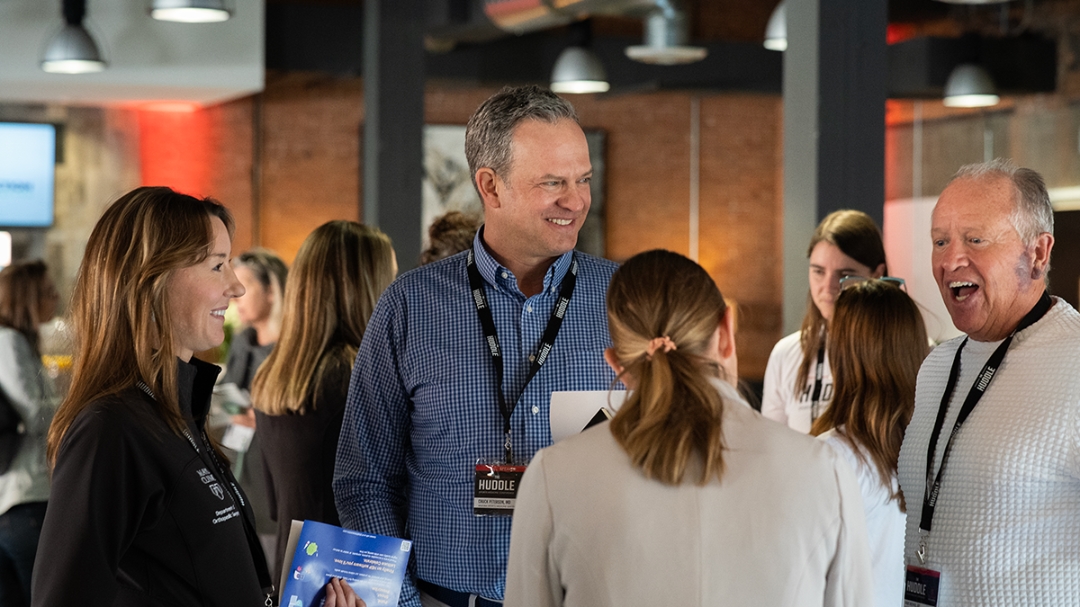Collaboration is key when it comes to caring for athletes. Everyone – physicians, athletic trainers, physical therapists, strength coaches, and more – must work together, learn from each other, and work as a cohesive group in the best interest of the athletes in their care. The Huddle Sports Medicine Conference brings together sports medicine professionals to educate and collaborate about athlete care. The Huddle is an important extension of Spooner Sports Medicine, which holds a strong commitment to collaboration, communication, and athlete-centered care. When sports medicine is done well, we come together, learn from each other, and work as a cohesive group in the best interest of the athletes in our care. This past year, speakers from all over the world came to share their expertise on treating the hamstring, the female athlete, the foot and ankle, and the ACL.
Hamstrings
Hamstring injuries are one of the most prevalent injuries among athletes. Depending on the grade of the injury, athletes can return to play within a few weeks, or they will be out for the season. So, why do they happen?
For too long we have attributed hamstring injuries to a lack of flexibility but it plays a small role in the risk for injury. Some hamstring injuries occur because of the way the athlete interacts with the ground, including proper movement, strength, and power. Understanding the importance of the entire kinetic chain from the ground up and its effect on the hamstring is vital to the treatment of these injuries.
What do we do with this information? Continue to train proper form and proper movement mechanics, build strength, and work with sports medicine professionals who understand that every program, whether to reduce the chance of injury or return you to sport post-injury, needs to remain fluid and meet the needs of the individual.
Female Athlete (RED-S)
Relative energy deficiency in sport (RED-S) is a disorder that affects all athletes; however, female athletes are at a higher risk for developing it, oftentimes because they are at a higher risk of disordered eating than their male counterparts.
RED-S occurs when there is less energy taken in than is being expended. For females, this can result in a loss of period. Whenever a female loses their period, it is an indicator of low energy availability in the body. Athletes with RED-S will spend less time in sports due to the multitude of issues it causes.
The symptoms that come with RED-S for athletes, regardless of gender can be decreased coordination, decreased muscle strength, fatigue, gastrointestinal problems, and decreased bone density. All of this together impairs the athlete’s performance and puts them at risk of injury and illness.
Every athlete wants to compete at their highest level. If you are suffering from any of the symptoms of Red-S, make sure you see a physician who can properly diagnose you and work with your entire sports medicine team to get you on the right path to recovery.

Foot and Ankle
A great deal of athletic growth starts with the health of your feet. The foot is the translator of your body to the ground. Maximizing the mobility, stability, and strength of the foot gives athletes a platform for success.
One overlooked part of the foot is the midfoot. Often, this part of the foot is quite rigid. However, the midfoot should be mobile to adapt to different surfaces and move the body in different directions.
The midfoot is also the biggest mover when you are walking or running. During both of these activities, each foot takes on a great deal of force. Without proper mobility, that force will not be able to be properly directed up your kinetic chain.
ACL
There are over 200,000 ACL injuries every single year. The common way to repair a tear is through a reconstruction utilizing a graft from your patellar tendon, your hamstring, your quadricep, or your IT band. These reconstructions are effective for giving athletes similar knee stability for sport, however, quad and/or hamstring strength- depending on graft site- is weaker post-operatively.
A new procedure with a repair rather than a reconstruction is available now for athletes. The BEAR™ Protocol inserts the Bear™ Scaffold to bridge the gap of the torn ACL. This allows for the ACL to actually regrow. This is a new procedure, but it is showing promise with post-operative strength and a decreased chance of post-operative osteoarthritis.
Returning to sport after an ACL reconstruction or repair takes time. When athletes are choosing a place to heal and get stronger post-surgery, be sure to have a team of sports medicine professionals who are taking into consideration your injury history and your sports specific needs. Also, if you are a female athlete, make sure your team has specific strategies for you to perform your best in sport.
Your sports medicine team – made up of your physician, athletic trainer, physical therapist, strength coach, coach, sports psychologist, and/or nutritionist – all work together to help you perform your best. Our collective goal is to help you achieve your peak level of performance and keep you moving and feeling your best on and off the field.
Stay tuned for The Huddle 2024! If you want to be among the first to receive update from The Huddle, join The Huddle mailing list today. You can still join The Huddle virtually here.

